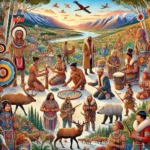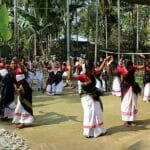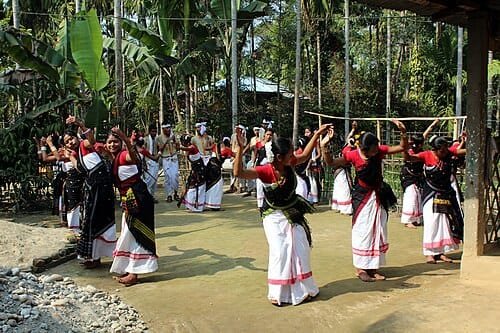✍️ By Vijay Oraon | FirstPeople.in
In the changing landscape of Indian democracy, one of the most significant and inspiring developments has been the rise of tribal leadership at both state and national levels. Once confined to the margins, Adivasi (tribal) voices are now occupying top constitutional, executive, and political positions in India, rewriting the narrative of inclusion, governance, and identity.
🟤 A Historic Presidency: Droupadi Murmu
In 2022, Droupadi Murmu, a teacher-turned-politician from Odisha’s Santhal tribe, became the 15th President of India — the first tribal and second woman to hold the office. Born in a remote village in Mayurbhanj district, Murmu’s journey reflects the deep strength, humility, and aspirations of India’s tribal communities.
As President, she symbolizes representation at the highest constitutional level, bringing indigenous perspectives into India’s most solemn national ceremonies and moral leadership spaces.
🏛️ Kiren Rijiju: The First Tribal Law Minister
Another landmark moment came with Kiren Rijiju, a leader from the Nyishi tribe of Arunachal Pradesh, who made history by becoming India’s first tribal Law Minister in 2021. In 2024, he was appointed the Union Minister of Minority Affairs.
Rijiju, known for his strong and unapologetic tribal identity, said:
“I am the first tribal Law Minister of India.”
His contributions to national legal reform, Northeast development, and minority welfare place him at the heart of India’s evolving socio-political identity.
🗳️ India’s 8 Tribal Chief Ministers (As of 2025)
🔥 Tribal leaders are heading 8 Indian states, making this era one of the most representative for indigenous communities in India’s political history:
State Chief Minister Tribe/Community
Jharkhand Hemant Soren Santhal
Odisha Mohan Charan Majhi Santhal
Chhattisgarh Vishnu Deo Sai Kanwar
Arunachal Pradesh Pema Khandu Monpa
Nagaland Neiphiu Rio Angami Naga
Meghalaya Conrad Sangma Garo
Mizoram Lalduhoma Mizo
Sikkim Prem Singh Tamang (Golay)* Gorkha (tribal-aligned)
Prem Singh Tamang is not constitutionally ST but represents a tribal-cultural identity among Sikkim’s Gorkha community.
🌿 Adivasi Governance: More Than Just Symbolism
The presence of tribal CMs and national ministers is more than tokenism. These leaders are actively:
Advocating for land and forest rights.
Implementing PESA (Panchayats Extension to Scheduled Areas) Act and Forest Rights Act.
Pushing for Sarna Dharma Code and tribal religious autonomy.
Resisting displacement due to mining, dams, and extractive industries.
From Hemant Soren’s vocal support of tribal identity and Sarna code to Conrad Sangma’s work on tribal entrepreneurship, tribal CMs are reshaping development models to align with indigenous values.
🎬 Beyond Politics: Cultural, Environmental & Youth Leadership
The rise in political leadership is mirrored in tribal media, activism, and environmentalism:
Archana Soreng (UN Climate Youth Advisor)
Gladson Dungdung (Human Rights Activist)
Dayamani Barla (Journalist & Anti-Mining Leader)
Niranjan Kumar Kujur (Filmmaker redefining Adivasi cinema)
Ruby Hembrom (Founder, Adivaani, a tribal publishing house)
Digital platforms like Adivasi Lives Matter and FirstPeople.in have become powerful tools for youth voices, language revival, and counter-stereotyping of tribal identity in mainstream media.
🧭 What This Shift Means
For decades, Adivasi communities were viewed only through the lens of deprivation, backwardness, or exoticism. Today’s tribal leadership challenges that:
They are administrators, reformers, and legislators, not just protestors.
They are storytellers, scholars, and spiritual custodians, not just victims.
They are digital warriors, armed with Instagram handles, mobile journalism, and podcasts.
This transition from resistance to governance, from outsiders to insiders, is reshaping what it means to be Indian in the 21st century.
🎤 Tribal India Is Not Waiting Anymore
The story of tribal India is no longer about being “included.” It is about leading.
As Droupadi Murmu sits in Rashtrapati Bhavan, and tribal Chief Ministers run powerful states, the narrative has decisively shifted. But challenges remain — land alienation, cultural erasure, displacement, and policy neglect are still pressing issues.
Yet, with leaders like Hemant Soren, Kiren Rijiju, Mohan Charan Majhi, and others, a new path is being paved. A path where tribal India is not merely seen, but heard, respected, and followed.
🟢 Author’s Note:
This article is part of FirstPeople.in’s ongoing series on Adivasi Representation and Leadership in Contemporary India. Follow us for in-depth stories, interviews, and research from the heart of indigenous communities.












